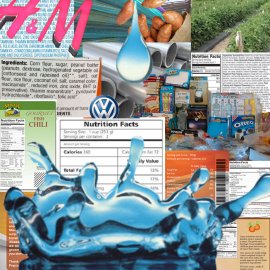Water Consumption Labeling
-
English
-
ListenPause
I’m Peter Neill, Director of the World Ocean Observatory. In my book, THE ONCE AND FUTURE OCEAN, I argue for greater public understanding of how we consume water, how we price water, and how we manage water as the single most important resource on earth and as the key component in a new paradigm for value, structure, and behavior in the 21st century. I use as one example the image of walking down a supermarket aisle and hearing a torrent of cascading water in untold volume used for the processing, packaging, and distribution of the products found on the shelves. Water is a fundamental externality in the financing of production, rarely calculated into the price in that it is often free or heavily subsidized for the manufacturer and incidental to specific accounting for the specific product. Thus, the true cost of the most important resource, not just to the making of one item or another, but to the overall availability of the water consumed to the larger needs of society – drinking water, sanitation, irrigation, and much, much more – is left out of the financial equation. To provide an example, this morning I took from the shelf a paper package of Imagine Natural Creations tomato bisque soup. It was covered with notifications and labels – USDA Organic; certified organic by Quality Assurance International; 25% less sodium than the leading competitor (630 to 880 mg); recyclable ONLY where facilities exist; Forest Sustainability Council MIX certification of paperboard from responsible sources; further assertion that the product within was organic, contained non-GMO ingredients, was vegetarian, and had no MSG added and no artificial ingredients or preservatives. The nutrition facts were comprehensive. Finally, the ingredients were listed: organic tomatoes, organic cream or milk, organic evaporated case syrup, organic corn starch, sea salt, organic basil, citric acid, organic spices, and last but not least, water, filtered, and also, presumably, organic. Indeed, the package declares an exhausting awareness and purposeful dedication to the health of its consumers, to the highest quality of the purest ingredients, and to the world forest ecosystem – the good people at Imagine Natural Creations are to be congratulated for their concern and commitment. And, as added value, the tomato bisque tastes just fine. But what was missing from all this information? How much water was used in the growing of those tomatoes? How much water was used in the processing and the making? How was the water waste from production treated and disposed of? Where did the water come from and was its availability subsidized by the costs of public treatment and distribution? Do any of the certifications cited include water use in the criteria applied? How much water was used in the production of the packaging, the distribution of the product, the continuous progress from raw ingredient to point of sale? The point here is that the most important component remains hidden, an unarticulated value, positive and negative, that might enter our calculation of its desirability for consumption. Would it not be as useful to know a rating of water use against that of a competitor as much as the use of salt? If we are concerned about GMO ingredients and demand such labeling from our legislators as a public responsibility, why should we not be equally concerned about water consumption labeling with equal and immediate impact on our individual and public health? Would it not be a constructive project for one of our water-directed institutes, concerned with critical water availability and use around the world to define the principles and criteria for such an evaluation and move for voluntary, even legislative adoption of such information to be listed not just on food products but on every product and its packaging, from smart phones to computers to automobiles, from metal, paper and wood products, iron, steel, and aluminum, from fracking for oil to the cooling of nuclear generators and our houses and offices, from the growing of all things eaten from meat to vegetables and from all beverages imbibed from beer to soda to coffee to, yes, even organic soups? Truth in labeling. It’s time for us to know and publicly declare how the circles and cycles of water work on our consummate behalf and how we must protect and recycle that essential value as the key ingredient in our future sustenance. Let’s certify water! We will discuss these issues, and more, in future editions of World Ocean Radio. WORLD OCEAN RADIO IS A PROJECT OF THE WORLD OCEAN OBSERVATORY, IN ASSOCIATION WITH WERU FM, BLUE HILL, MAINE. FIND OUR PODCAST ON ITUNES, AND AT WORLD OCEAN OBSERVATORY DOT ORG.
Product labeling is a thorough and complicated business, from nutrition facts and ingredients on food labels to non-GMOS, organics, recycling information and much more. But a key component is missing from all of this labeling and accountability: the calculation of water used to grow, mine, process, produce, package, transport, and dispose of the infinite things consumers consume. In this episode of World Ocean Radio host Peter Neill will ask if it would not be useful to know a rating of water use—how much is used, where it comes from, and how production waste is disposed of—before we make an educated, mindful purchase?
About World Ocean Radio
Peter Neill, Director of the World Ocean Observatory and host of World Ocean Radio, provides coverage of a broad spectrum of ocean issues from science and education to advocacy and exemplary projects. World Ocean Radio, a project of the World Ocean Observatory, is a weekly series of five-minute audio essays available for syndicated use at no cost by college and community radio stations worldwide. A selection of episodes is now available in Portuguese, Spanish, French, Swahili, and Mandarin, enabling us to reach 75% of the world's population. For more information, visit WorldOceanObservatory.org/world-ocean-radio-global.
- Login to post comments



